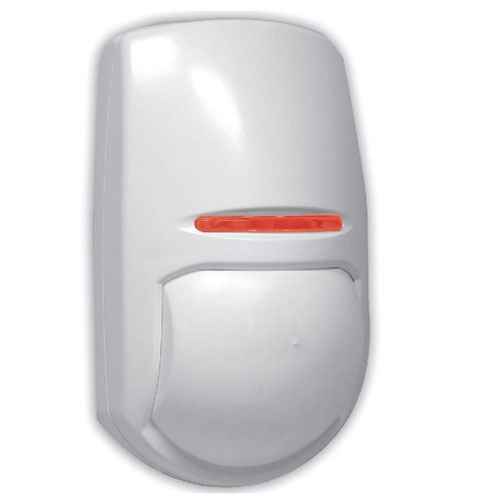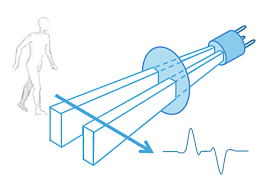Passive Infra-Red (PIR) movement detection.

The PIR detector is an area intrusion detection device which is used in most modern intruder alarm installations to some degree. PIR detectors are triggered by heat and movement.
The PIR is passive in the sense that it only receives infra-red energy and is not a transmitter.
The PIR unit detects via many infra-red detection areas spread via the detector's Fresnel lens into a wide pattern usually covering 90 degrees or more.
These detection areas attempt to detect changes in temperature.

The PIR does this by using a sensor device called a pyro. The pyro device is made up of two sensing elements that compare amounts of infra-red radiation received.
When the sensor is idle, both elements detect the same amount of infra-red radiation - which is the ambient amount radiated within the detection area.
When a warm body like a human or animal passes by, it first triggers one pyro element, which causes a positive differential change between the two halves.
When the warm body leaves the sensing area, the reverse happens, whereby the sensor generates a negative differential change.
These change pulses are what is detected.

Therefore a PIR device's sensitivity can be adjusted by changing it's pulse count setting.

The Fresnel Lens on the PIR allows for multiple detection areas for the pyro sensor elements, all angled in a set pattern to cover the area.
Since the PIR detector will be much more reactive if the detection areas are crossed, it is better to site these detectors where a potential intruder is likely to walk across the path of detection, rather than walk between the detection areas.
This is one reason that wall mounted versions are usually fitted in the corner of a room, since the best coverage can be achieved from a corner. Check out this drawing below:

We can see above that a standard wide angle wall mounted unit has many detection areas. These detectors are available with differing detection ranges.
The most popular models for internal use are usually 12 or 15 metre range devices.
Curtain lenses are available that provide a narrow coverage area:

Ceiling mounted PIR detectors provide a 360 degree coverage up to –mtrs.

Quad PIR
Quad Element PIR detectors are equipped with a quad element pyro package, which is essentially two pyro devices which compare against each other to help filter out false alarms.


Dual Technology Detectors (Dualtec/ Dualtech)
Dual technology detectors combine two differing technologies to help filter out false alarms in challenging environments - the most common versions combine PIR detection with microwave detection technology, although PIR with ultrasonic detection versions are available.
Dual technology detectors operate as two separate detectors, each detecting movement and IR.
With a dual passive infra-red / microwave detector, if the microwave unit activates, the detector waits for given period of time to determine if the passive infra-red unit also alarms.
If so, an alarm activation signal is sent but if not, the detector resets. Both detectors must activate within a prescribed time window for an alarm signal to be generated.
As these detectors are using both active and passive detection principles, false alarm problems are reduced.
This is because the environmental causes of false alarms for the active detectors are different from those for the passive detector.
What activates a microwave or ultrasonic detector would not affect a passive infra-red.
The two technologies have differing coverage patterns and in the case of microwaves the detection can pass through some materials.
In the picture below the microwave detection is located just underneath the connection terminals, with the PIR pyro element below that.

TMD (Twin Movement Detector)
This is two individual PIR detectors in one housing (one dual technology, one not), usually with differing coverage patterns for maximum detection.
The detectors have separate zones on the intruder alarm system to allow for signalling of a confirmed intruder detection activation from a single device.


Tip:
Try not to aim the PIR straight at a window as car headlights and direct sunshine can set them off. Don't place the PIR where it will directly view an open fire.
Don't fit it above a radiator, as the rising heat currents can trigger the unit also.
In summary:
The PIR receives far infra red energy. Has a detection pattern which is divided into elements in order to measure changes in temperature.
The Quad PIR is able to filter out false alarm causes more effectively than a standard unit with dual pyro elements.
There are essentially two different types - corner mounted or ceiling mounted.
Corner mounted types have a 90° volumetric range in the order of 12-15 metres when at a height of 2.3 m.
Ceiling mounted types have a 360° range in the order of 12-15 metres. They should only be attached to secure ceiling surfaces.
Hazards/false alarm sources
The PIR can be affected by:
Heat sources, Fires
Sunshine through windows,
Fast changing climatic conditions
Unstable power supplies
Insecure fixing of the detector or cover
Tools required to fit:
1. No.2 pozidrive or philips for fixing screws (usually 1 1/2x8 countersunk)
2. 3mm flat blade screwdriver for connection of terminals
3. a drill with a 5.5mm masonry bit may be required depending on mounting materials, where used, rawlplugs will also be needed.
